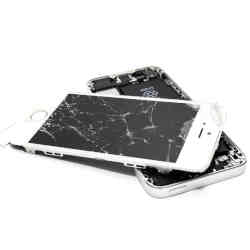
Mobile device displays have come a long way from the basic liquid-crystal displays used on the earliest handheld devices, such as the original Apple Newton or Palm Pilot. The screens on today's smartphones, tablets, and laptops can display a dizzying array of colors, reproduce fast-motion sequences with little or no blur, and in some cases, can even be treated to work in bright sunlight.
The key issue that still haunts many users is the fear of scratching or breaking a phone's screen, which can render the device virtually unusable and saddle the owner with a hefty repair bill to fix the cracked or scratched screen. According to a 2022 Secure Data Recovery survey, 44% of Americans drop their phone at least once a week, with 23% of respondents indicating the hard floors of bathrooms pose a major threat to screen integrity.
While devices using tempered glass displays such as Corning's Gorilla Glass on Android phones or Ceramic Shield Glass on iPhones are impact and scratch-resistant, they are still susceptible to breakage, particularly if they are dropped and the impact occurs on the screen edge. A blow to the side of the screen creating a small chip can quickly expand to shatter the entire screen.
However, a team of scientists led by researchers from Australia's University of Queensland have developed new technology that may be able to create mobile device displays that are resistant to scratching and breaking not by being harder or stronger than regular glass, like the tempered glass used today, but by being more flexible.
"The aim of the research is to introducing flexibility to the glass, while still keeping their anti-scratching properties," explains Jingwei Hou, ARC Future Fellow in the School of Chemical Engineering at the University of Queensland. "So, the glass won't break under sudden external stress (as when it is dropped or smashed). We are not creating a super-hard glass [like] Gorilla Glass, as usually hardness comes at a price of brittleness."
According to the research team, the goal was to stabilize the material and prevent toxic lead ions from leaching out, a key consideration for a consumer device. The finished prototype product exhibits "high stability" when exposed to heat, light, air, and humidity, and was able to retain 80% of its luminescence after 10,000 hours of water immersion, according to the research, which was published in the journal Science (DOI: 10.1126/science.abf4460).
Hou and his team used a process involving liquid-phase sintering of lead halide perovskites (nanocrystals comprised of calcium titanium oxide minerals) and metal-organic framework glass to create a material that would not only work as a resilient display technology, but also could be adapted to harvest sunlight into energy, which could be used to create solar panels or, as Hou says, screens that could also serve as power sources. "One of the research themes we are actively looking at is to develop the thin film with perovskite so it can generate electricity under direct sunlight," Hou says, noting that his research has received interest from major venture capital firms, with an expected timeline of about 5 years from prototype to commercialization.
This technology may have many applications, as Hou says the "aim is to combine the plastic and metallic properties together, [offering] flexibility and an anti-scratch surface." He adds, "The application can be mobile phone screens, LEDs and displays, and some smart windows for climate control."
Hou's research is the latest entrant in the field for so-called 'unbreakable' screens. In 2018, Samsung Display Company heavily promoted the development of screen technology that was tested by UL Solutions and verified to meet military specification 810G, which refers to the Transit Drop Test, Method 516.6 Procedure IV. To receive certification, a device must be dropped onto concrete 26 times from a height of 48 inches onto every corner and edge. According to a Samsung Display spokesperson, the panel that was tested by UL is being used now in some smartphones, including by the flagship Galaxy phone.
Samsung Display has focused on the use of flexible OLED displays, which were found to be resistant to cracks or breakage after testing by France's Bureau Veritas in which Samsung's flexible OLED display was folded more than 30,000 times in extreme cold during 2021 testing, or when it was folded 150,000 times at high temperatures this year.
"The biggest issue to remember when assessing the durability of display technology is to closely review how a screen or phone has been evaluated to support and validate the "unbreakable" claim," explains Michael Sakamoto, senior business manager for UL Solutions. "If I took a hammer or a jackhammer and put it on a cellphone, it could break," he says. "If you're looking at a product that says it has passed the test for MIL-STD 810G, you want to look further into the test method before you assume something. If you dropped (the device) from one foot, it could be quite different than six feet."
Keith Kirkpatrick is principal of 4K Research & Consulting, LLC, based in New York City.



Join the Discussion (0)
Become a Member or Sign In to Post a Comment